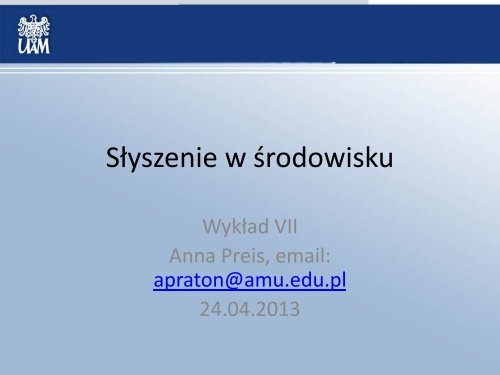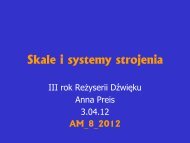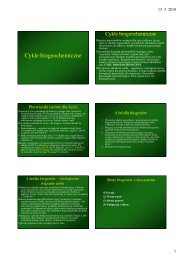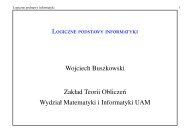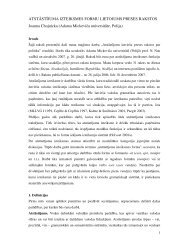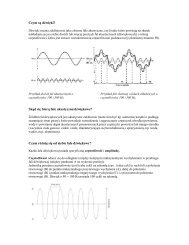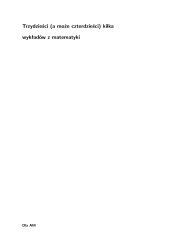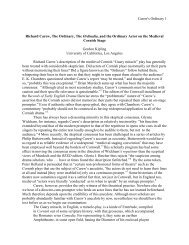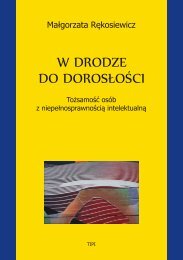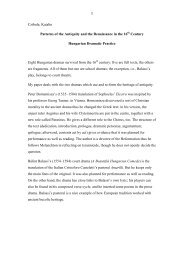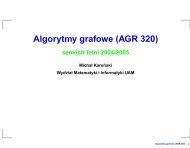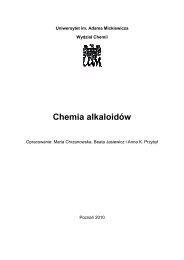Noise annoyance and its measurement
Noise annoyance and its measurement
Noise annoyance and its measurement
You also want an ePaper? Increase the reach of your titles
YUMPU automatically turns print PDFs into web optimized ePapers that Google loves.
Słyszenie w środowisku<br />
Wykład VII<br />
Anna Preis, email:<br />
apraton@amu.edu.pl<br />
24.04.2013
How to test if soundscape changes into noisescape?<br />
<strong>Noise</strong> <strong>annoyance</strong> <strong>and</strong> <strong>its</strong> <strong>measurement</strong><br />
Anna Preis<br />
apraton@amu.edu.pl
L<strong>and</strong>scapes
Soundscape
Soundscape<br />
The Tuning of the World formalized the soundscape terminology Schafer had devised<br />
during his field studies with the WSP:<br />
Background sounds he defined as “keynotes” (in analogy to music where a keynote<br />
identifies the fundamental tonality of a composition around which the music<br />
modulates);<br />
Foreground sounds (intended to attract attention) are termed “sound signals.”<br />
Sounds that are particularly regarded by a community <strong>and</strong> <strong>its</strong> visitors are called<br />
“soundmarks”—in analogy to l<strong>and</strong>marks.<br />
Natural examples of the latter include geysers, waterfalls <strong>and</strong> wind traps while<br />
cultural examples include distinctive bells <strong>and</strong> the sounds of traditional activities.<br />
(Schafer 1977a: 9, 55-56, 173-175, 272-275; Truax 1978: 68, 119, 127; 1984: 22,<br />
58-60).<br />
K. Wrightson, (2000) An Introduction to Acoustic Ecology.The Journal of Acoustic<br />
Ecology, 1(1).<br />
Soundscape exists through human perception of the acoustic environment<br />
A. L. Brown (2010) Soundscapes <strong>and</strong> environmental noise management <strong>Noise</strong><br />
Control Eng. J., 58(5)
Underst<strong>and</strong>ing urban <strong>and</strong> natural soundscapes<br />
• Dick Botteldooren, Department of Information Technology, Ghent University, Gent,<br />
Belgium.<br />
• Catherine Lav<strong>and</strong>ier, Laboratory MRTE, University of Cergy Pontoise, F-95000<br />
Cergy Pontoise, France<br />
• Anna Preis, Institute of Acoustics, Adam Mickiewicz University, Poznan, Pol<strong>and</strong><br />
• Daniele Dubois, Institut Jean le Rond d'Alembert, Equipe LAM, CNRS, France,<br />
INCAS3, Assen, The Netherl<strong>and</strong>s.<br />
• Itziar Aspuru, Labein-Tecnalia, Environmental Unit, Spain<br />
• Catherine Guastavino, McGill University, School of Information Studies <strong>and</strong><br />
CIRMMT (Centre for Interdisciplinary Research on Music, Media <strong>and</strong> Technology),<br />
Montréal, QC, Canada.<br />
• Lex Brown, Griffith School of Environment, Griffith University, Nathan 4111,<br />
Australia<br />
• Mats Nilsson, Department of Psychology, Stockholm University, Sweden<br />
• Tjeerd C. Andringa, Artificial Intelligence, University of Groningen, The<br />
Netherl<strong>and</strong>s. INCAS3, Assen, TheNetherl<strong>and</strong>s.<br />
Working Group 1 of the COST action<br />
“Soundscapes of European cities <strong>and</strong><br />
l<strong>and</strong>scapes”
Professor Lex Brown, Griffith University, Australia<br />
<strong>Noise</strong> Control<br />
Approach<br />
Sound as waste<br />
Concerns sound of discomfort<br />
Human response related to<br />
level of sound<br />
Measures by integrating across<br />
all sound sources<br />
Manages by reducing level<br />
Soundscape Approach<br />
Sound as resource<br />
Concerns sounds of preference<br />
Preference often unrelated to<br />
level - quiet not the objective<br />
Requires differentiation<br />
between sound sources –<br />
wanted sound from unwanted<br />
sound<br />
Manages by “wanted sounds”<br />
masking “unwanted sounds”
Sound environment versus noise environment<br />
Soundscape<br />
• Perception <strong>and</strong> recognition of<br />
different sound sources in the<br />
environment<br />
• Soundscape perception: auditory<br />
scene analysis based on streams<br />
segregation<br />
• Criteria of segregation: loudness,<br />
pitch, timbre, location<br />
• Scaling the preferences of<br />
different soundscapes<br />
<strong>Noise</strong>scape<br />
• Occurrence of noise which disturbs<br />
perception to such a degree that it is<br />
impossible to recognize sound sources in<br />
the environment<br />
• <strong>Noise</strong>scape as a source of disturbance of<br />
human activity such as communication,<br />
work, studying<br />
• <strong>Noise</strong>scape threshold: degree of<br />
disturbance which makes the<br />
performance of a given activity<br />
ineffective<br />
• Speech intelligibility in noise is well<br />
defined <strong>and</strong> could be a measure of noise<br />
<strong>annoyance</strong> related to communication<br />
activity
Disturbed l<strong>and</strong>scape
Disturbed soundscape = noisecape<br />
White noise<br />
Specific noise
<strong>Noise</strong> <strong>annoyance</strong><br />
Traditional approach<br />
• L DEN one noise index<br />
• <strong>Noise</strong> maps for different sound<br />
sources<br />
• St<strong>and</strong>ardized method of noise<br />
<strong>annoyance</strong> scaling<br />
• <strong>Noise</strong> parameter is scaled<br />
• Annoyance is related to noise<br />
parameter<br />
• (Dose –response characteristics<br />
%HA versus L DEN )<br />
<strong>Noise</strong>scape approach<br />
• Difficulty in performing a<br />
given activity disturbed by<br />
noise is scaled<br />
• The degree of difficulty in<br />
performing a given activity is<br />
a measure of noise<br />
<strong>annoyance</strong> assessment<br />
• <strong>Noise</strong> <strong>annoyance</strong> assessment<br />
depends on the degree of<br />
disturbance in the human<br />
activity
Traditional approach: noise <strong>annoyance</strong> in rest<br />
• ISO/TS 15660:2003, recommended by ICBEN<br />
• verbal rating scale: Thinking about the last (...12 months or so),when<br />
you are here at home, how much does noise from (….noise source...)<br />
bother, disturb, or annoy you?<br />
• (1) Not at all? (2) Slightly? (3) Moderately? (4) Very? (5) Extremely?<br />
• numerical rating scale: Thinking about the last (...12 months or<br />
so),what number from zero to ten best shows how much you are<br />
bothered, disturbed, or annoyed by the presented noise events?<br />
• If you are not at all annoyed choose zero, if you are extremely<br />
annoyed choose ten, if you are somewhere in between, choose a<br />
number between zero <strong>and</strong> ten.<br />
Preis, A., Kaczmarek, T., Wojciechowska, H., Żera, J., Fields, J.M. (2003), "Polish version of the st<strong>and</strong>ardized noise<br />
reaction questions for the community noise surveys," International Journal of Medicine <strong>and</strong> environmental Health<br />
16(2): 155-159
<strong>Noise</strong> <strong>annoyance</strong> related to rest <strong>and</strong><br />
communication activity<br />
• <strong>Noise</strong> disturbs<br />
rest<br />
• <strong>Noise</strong> disturbs<br />
communication activity<br />
traditional scaling of<br />
noise <strong>annoyance</strong> (ISO/TS<br />
15660:2003,<br />
recommended by ICBEN)<br />
verbal rating scale<br />
numerical rating scale<br />
difficulty of comprehending<br />
speech in noise is a<br />
measure of noise<br />
<strong>annoyance</strong><br />
speech intelligibility score
<strong>Noise</strong> <strong>annoyance</strong> scale related to noise parameters<br />
sound<br />
parameters of<br />
sound increase<br />
L, S, R, F<br />
different models<br />
of noise <strong>annoyance</strong><br />
unwanted sound<br />
= NOISE<br />
<strong>Noise</strong> <strong>annoyance</strong> scale related to communication - speech intelligibility scores<br />
work<br />
work<br />
disturbance<br />
<strong>Noise</strong>scape- measure of work<br />
disturbance<br />
soundscape<br />
noise<br />
communication<br />
communication<br />
disturbance<br />
<strong>Noise</strong>scape-measure of<br />
communication disturbance<br />
Speech<br />
intelligibility in<br />
noise<br />
rest<br />
rest<br />
disturbance<br />
<strong>Noise</strong>scape- measure of rest<br />
disturbance
Rest<br />
<strong>Noise</strong> <strong>annoyance</strong> scaling
<strong>Noise</strong> <strong>annoyance</strong> scaling<br />
Communication activity
<strong>Noise</strong>scape related to the communication activity<br />
Equal difficulty in speech recognition<br />
Equal <strong>annoyance</strong> rating<br />
SRT ---- 50% speech recognition<br />
Averaged speech reception thresholds for nine<br />
environmental noises expressed as an arithmetical<br />
means <strong>and</strong> 95% of coincidence interval.<br />
The measure of difficulty of speech comprehension<br />
for nine noises expressed as medians <strong>and</strong> their<br />
interquartile ranges.<br />
A. Preis, H. Hafke-Dys, T. Kaczmarek, T. Gjestl<strong>and</strong> (2011) The relationship between speech reception thresholds <strong>and</strong> the<br />
assessment of <strong>annoyance</strong> caused by different environmental noises <strong>Noise</strong> Control Eng. J. 59 (4), 408-414.
One point relationship between noise <strong>annoyance</strong><br />
<strong>and</strong> speech intelligibility<br />
Difficulty in speech<br />
comprehension<br />
<strong>annoyance</strong> related to<br />
communication activity<br />
Speech intelligibility<br />
What about the other points?
The relationship between speech intelligibility <strong>and</strong><br />
the assessment of <strong>annoyance</strong> caused by<br />
environmental noises<br />
Anna Preis, Honorata Hafke-Dys, Tomasz Kaczmarek<br />
Institute of Acoustics, Adam Mickiewicz University, Poznan, Pol<strong>and</strong><br />
Truls Gjestl<strong>and</strong><br />
SINTEF ICT, Trondheim, Norway
Aim of the study<br />
To find out if the speech intelligibility in noise can be<br />
used as the <strong>annoyance</strong> measure of this noise<br />
To assess the difficulty in speech comprehension in<br />
noise<br />
• Aniansson, G., Bjὂrkman, M., “Traffic noise <strong>annoyance</strong> <strong>and</strong> speech intelligibility in persons with normal<br />
<strong>and</strong> person with impaired hearing” Journal of Sound <strong>and</strong> Vibration 88(1), 99-106, (1983).<br />
• Ellis L.W, Pakulski L., “Judgments of speech intelligibility <strong>and</strong> speech <strong>annoyance</strong> by mothers of children<br />
who are deaf or hard of hearing” Perceptual <strong>and</strong> motor skills 96, 324-8, (2003).
<strong>Noise</strong> L AeqT (dB) SRT (dB)<br />
Bus_in 83.5 -28.6<br />
Tram_1_in 76.5 -23.4<br />
Train_out 75.0 -20.4<br />
Tram_out 73.9 -15.1<br />
Street 73.8 -13.0<br />
School_in 73.5 -10.0<br />
Plane_out 71.8 -9.8<br />
Babble noise 68.2 -7.7<br />
50% speech intelligibility<br />
Speech level was 65dB <strong>and</strong> noise level was respectively -6, -4, -2,<br />
0=SRT, 2, 4, 6. Each subject was presented with his SRT from the<br />
previous experiment
Experiments<br />
Experiment I:<br />
part 1: speech intelligibility was measured for eight<br />
environmental noises at seven signal-to-noise ratios (SNRs).<br />
part 2: for these SNR values, the participants assessed the<br />
difficulty in speech comprehension<br />
Experiment II:<br />
the st<strong>and</strong>ard method of noise <strong>annoyance</strong> assessment was used<br />
to the same noises as in Experiment I<br />
Participants<br />
nineteen university students, 8 males <strong>and</strong> 11 females aged<br />
between 20 <strong>and</strong> 25, took part in both psychoacoustic<br />
experiments
Are they equal or not?<br />
Annoyance related to<br />
communication activity<br />
• difficulty in speech<br />
comprehension<br />
Annoyance related to<br />
the rest<br />
• traditional noise <strong>annoyance</strong><br />
assessment<br />
speech communication<br />
rest?<br />
Experiment 1 part 2 Experiment 2
Speech samples<br />
The Polish sentence matrix test (PSMT). The speech was presented to<br />
the participants at the constant level of 65 SPL.<br />
The PSMT consists of 10 names, 10 verbs, 10 numerals, 10 adjectives,<br />
<strong>and</strong> 10 nouns, i.e. a total of 50 different words that can be used<br />
to build 100000 different sentences. More details <strong>and</strong> properties of<br />
a PSMT can be found in Ozimek et al., 2010.
<strong>Noise</strong> samples - maskers<br />
• noise in a school corridor during the break.<br />
• a busy road taken about 35 meters from the middle of the<br />
road.<br />
• a bus interior (Neoplan) during normal drive conditions.<br />
• a tram type 105N2k-2000 interior during the normal drive<br />
conditions.<br />
• a jet airplane over-flight.<br />
• an Inter-City train pass-by taken 25 m from the rail track.<br />
• a tram type 105n pass-by taken 25 m from the rail track.<br />
• babble noise (uniform noise created from a speech by<br />
averaging a large number of a Polish-language speech<br />
material).
Experiment I - part 1:<br />
Psychometric curve for speech intelligibility scores<br />
• The method of constant stimuli was used to obtain the<br />
speech intelligibility function for 7 values of SNR: -6 dB, -4<br />
dB, -2 dB, 0 dB, 2 dB, 4 dB, 6 dB. (SNR 0dB=SRT)<br />
• Each masker (8 environmental noises) was presented with a<br />
list of 20 sentences consisting of 5 r<strong>and</strong>omly chosen words<br />
from the Polish sentence matrix test (PSMT)<br />
• After the utterance of a sentence, a five column (names,<br />
verbs, numerals, adjectives) - 50-word push-button panel<br />
was displayed on an LCD screen. The participants’ task was<br />
to indicate words from the played-back sentence <strong>and</strong><br />
confirm their choice with the ‘OK’ button
Experiment I - part 2:<br />
Assessment of difficulty in speech comprehension<br />
After each utterance the participants were prompted to assess their difficulty in<br />
comprehending speech on an ascending scale from 0 to 10, where 0 means not at all<br />
difficult <strong>and</strong> 10 extremely difficult<br />
Push-button with a question about the difficulty in speech comprehension
Experiment I -results
Experiment I: results presented for each SNR
A<strong>annoyance</strong> rating – speech intelligibility<br />
y=9.0403e -0.749x
Experiment II:<br />
Assessment of noise <strong>annoyance</strong> presented alone<br />
Push-button with the question about the noise <strong>annoyance</strong><br />
scaling
Comparison of <strong>annoyance</strong> assessment
Results of Experiment I <strong>and</strong> II
Comparison of <strong>annoyance</strong> assessment
Conclusions<br />
• The best approximation of the relationship between the speech<br />
intelligibility <strong>and</strong> difficulty in speech comprehension is the following<br />
exponential function y=9.0403e -0.749x . This relationship was<br />
obtained for 7 different SNR values of eight environmental noises<br />
(Experiment I)<br />
• The differences between <strong>annoyance</strong> ratings which were assigned to<br />
the same noises during different activities, are not statistically<br />
significant (Experiment I <strong>and</strong> II) for SNR= 0, 2, 4, 6.<br />
• The outcome of this study is restricted to the situation where<br />
speech is presented to the listener at 65 dB sound level <strong>and</strong> the<br />
Polish sentence matrix test (PSMT) test is applied
• Thank you for your kind attention!<br />
• Dr Honorata Hafke-Dys, dr Tomasz Kaczmarek – co-authors of<br />
the presented results<br />
• Mgr Paweł Libiszewski , dr Jędrzej Kociński –technical<br />
assistance<br />
• This work was supported by the grant from the Polish-<br />
Norwegian Research Fund – project no. PNRF-167-AI-1/07.
Polish-Norwegian Research Fund<br />
Quality of public life determined by good hearing <strong>and</strong> speech<br />
communication<br />
SP 1<br />
Auditory research in the light of<br />
speech intelligibility<br />
SP 2<br />
Speech intelligibility as an index of the<br />
quality of public life<br />
WP 1<br />
Development of<br />
new sentence<br />
intelligibility tests<br />
for children <strong>and</strong><br />
improvement of<br />
recently designed<br />
tests for adults<br />
WP 2<br />
Development of new<br />
environment noise <strong>annoyance</strong><br />
index related to intelligibility<br />
data<br />
WP 3<br />
Application of new<br />
intelligibility tests to<br />
assessment of acoustic<br />
quality of hearing aids<br />
<strong>and</strong> implants<br />
WP 4<br />
Intelligibility tests aimed at<br />
evaluation of acoustic<br />
quality of public buildings<br />
<strong>and</strong> improvement of<br />
Internet <strong>and</strong> telephone<br />
procedures for self-testing<br />
intelligibility


